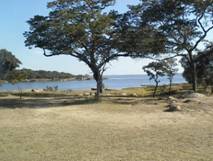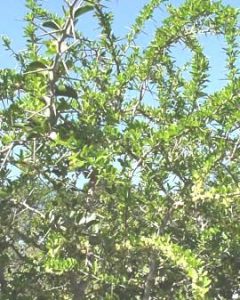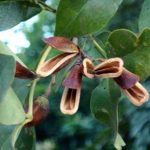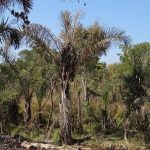TREE LIFE
JANUARY 1981
MASHONLAND CALENDAR

Bushman’s Point. Lake Chivero National Park, Zimbabwe. Photo: Wikipedia
Sunday January 18th : We are going to visit Bushman’s Point, Robert Mcilwaine National Park. Meet at 0900 hours at Marimba Shopping Centre on the Bulawayo Road to share lifts.
Directions : Go out on the Bulawayo Road and immediately after the Hunyani Bridge turn left. Fork left and cross the railway line. Once over the hill fork left again at the Arboretum turn off, thereafter follow National Park directions. Please note there is an admission charge to the Game Park which is 50c per adult and 25c per child.
As we are going in our own cars this field trip may be morning only or all day according to personal preference. For members who do not know this particular little “beauty spot” it is a fenced enclave within the game park, in which public can walk at large – there is plenty to see and worth, I think, bringing picnic lunch for an all day visit.
Tuesday January 6th : Botanic Garden Walk. Meet at public car park at 1700 hours.
Sunday 15th February : will be the AGM at Mr Gordon’s Farm. We plan a bus for this all day outing after the formal AGM business is over. Details will be in the next newsletter.
AYSHIRE BRANCH
The Annual General Meeting of the branch was held at Katara Farm, Raffingora on 18th November, 1980 and the outgoing committee were re elected en bloc. Mr. Le Clus remains as Chairman and Mrs Graves as Secretary.
Committee Members are : Messrs G. G. Moore and I. Basson, Mesdames Malan, Henderson and E. R. Jones.
TREE SOCIETY FIELD CARD – NAME CHANGES
We are all aware of the continual process of changes in botanic names and the very sound reasons behind such changes, as the frontiers of knowledge are advanced. Such awareness, however, does not alleviate the personal headaches, when one finds an old friend, long known by some Latinised jaw breaker, often painfully memorised in the first place, has suddenly and to we lay people, for no real reason, switched identify.
I personally find it very confusing when one’s female friends, etc. see fit to change their surnames for some reason or other, and it normally requires a period of years, not months, to adapt to the new name. Perhaps it is lucky that the habit of Latinising people’s names never caught on.
Anyway, this month we have decided to publish recent name changes as the current check list is concerned. One good thing, I notice, is that authors of reference books are usually quite good at quoting well established synonyms.
Acacia macrothysa = Acacia amythethyphylla
Ehretia amoena = Ehretia obtusifolia
Enterospermum rhodesiacum = Tarenna zimbabwensis
Fagara capensis = Zanthoxylum capensis
Fagara chalybea = Zanthoxylum chalybeum
Ficus sonderi = Ficus glumosa
Garcinia huillense = G. buchananii
Gardenia jovis-tonantis = Gardenia ternifolia subsp. jovis-tonantis
Gardenia spatulifolia = Gardenia volkensii
Heteromorpha arborescens = Heteromorpha trifoliate
Heteropyxis natalensis = Heteropyxis dehniae
Lannea stuhlmannii – Lannea schweinfurthii
Olea africana = Olea europaea subsp. africana
Ozoroa reticulata = Ozoroa insignis subsp. reticulata
Piliostigma thonningii = Bauhinia thonningii
Pterocarpus antunesii = Pterocarpus lucens subsp. antunesii
PRESIDENT’S REPORT FOR 1980
In my report for 1979 I said that the year’s activities had shown me that our Society was supplying a need to the country as a whole and not simply to our own members. I am happy to say that this has been equally true in 1980 and on behalf of the Society I have been very pleased to see that our opinions and status, albeit as enthusiastic amateurs, are respected in high places.
As for everyone, 1980 was a difficult year to start, I hope I am not being guilty of over optimism, but on the conservation scene, at lease, the year ends on a hopeful note. The times in which we live are not easy, and certainly the final removal of economic sanctions has brought about some of the changes some of us had hoped it would, however, despite disquieting symptoms of potential disunity in other aspects of life, conservation of our natural resources and paramount amongst such, trees, does seem to be one aspect of life in which thinking people are completely united. In saying this, I do not want to instill any idea of complacency, and quite clearly all concerned about conservation must continue to keep their wits about them and retain this unity of thought, to this end out continued cooperation with all other natural history societies, the Conservation Trust and all other like minded bodies is essential in the achievement of our objectives.
SALISBURY ACTIVITIES
As in previous years we have filled a programme of monthly field trips combined with educational botanic garden walks. The monthly field trip on the 3rd Sunday has remained as popular as ever, notwithstanding an increasing element of alternative choice to members with the lessening restriction on travel outside Salisbury. We have enjoyed fewer bus trips, five compared with nine in 1979. This reflects the increasing costs of bus travel more than removal of petrol rationing.
All outings whether through hired transport or otherwise went off like a well oiled machine, of special note was the May weekend trip to Umniati Power Station, and for this trip, in particular, as well as all the other field trips are due my grateful thanks to our outings sub-committee chaired by Mrs Lola Irvine.
MATABELELAND BRANCH
Again the year has seen a full programme of activity. Last year I commented on the fund of knowledge and expertise in this branch, we have managed to get quite a lot of this released in form of contributions to the newsletter, and I hope we see the very informative “Matopos Observations” continued in 1981 – I personally look forward to these contributions.
AYSHIRE BRANCH
This small but vital branch fully justified its existence and the record of its AGM held in November having just come to hand as I write, shows that in addition to the appellation “vital” applied from Salisbury, meaning “vital” to the Society as a whole, the branch still continues to display the vitality which characterised its formation over seven years ago.
Happily, in September, members from Salisbury were able to meet Ayrshire members on their home ground when we finally made the much postponed trip to Munaka Park, home of Mr. Townsend.
PROJECTS
The hard work of members past and present finally culminated, during 1980, in the registration of the Makabusi Woodlands Association and signing of the 33 year lease with Council. This ended the status of the whole Makabusi Woodlands as one of the projects, future work by members will be as members or ‘friends’ of the MWA although this does not rule out the possibility that we might become involved in some specialised project within the MWA organisation. There is still so much to do.
To keep it alive as a project we have made one official trip to our McIlwaine arboretum and here I admit we are battening in to the hard work of our Society in the past. There is work to be done now and if any members would like to volunteer we sorely need a special sub-committee to organise and control work at the Arboretum.
Binga, thanks largely to Mr. Dick Petheram has been a great success and I was happy to report progress during the year.
Lincoln Road Parkland continues to be a shining light in ‘grass roots’ self help; and we have continued our association with the National Trust in development of Epworth Balancing Rocks and Mabukuwene.
In my report for 1979 I made reference to “various other smaller projects” hoping that someone would ask me what they were. Nobody did ask, so I will tell you anyway.
In 1979, fostered by the growing awareness of the public of the worsening situation re natural woodland degeneration, because of the firewood shortage, this Society became involved in a number of ‘token’ plantings of trees. Our objective here was to see that a number of indigenous trees would get planted along with the inevitable exotic timber trees and fruit trees, and in a small way, thanks to trees donated for this worthy cause by Anton Ellert and a few other members, we managed to get indigenous trees planted where they otherwise would not have been planted, and in like fashion stimulate interest in these trees.
We continued this activity into 1980 and when the concept of the National Tree Day ordered by the Prime Minister came about we prepared to do our bit again and I am very happy to say trees grown by our members, once again, principally Anton, went to a lot of places, and were planted by a lot of important people, and once again much interest in indigenous trees was stimulated.
Perhaps planting is, in fact, the easiest part, follow up care is more difficult. We want to try and chart the future welfare of these trees.
GENERAL
In last year’s report under the heading HUNI CRISIS I expressed my opinion that government and Municipality were too prepared to talk about the crisis rather than act. This year central Government at least has shown more willingness to act and at the very well presented Fuel wood symposium arranged by Government in October a pathway was chartered and in the coming year I certainly hope to see real progress in this direction in the form of the beginnings of re-forestation projects in tribal lands.
In this context of re-forestation in the tribal lands expert after expert continues to bemoan the slow rate of growth of indigenous woody vegetation. Without wishing to belittle the part of that exotic timber trees must play both in our economy and our environment, we in the Tree Society know that these perpetual allegations of permanent slow growth are very much out of order, and a project I would like to see fostered by our Society is one to disprove not only the allegations of slow growth but when cost of establishment of stands of timber and maintenance are examined, compared to exotics established and cared for by non skilled personnel our indigenous trees do not fall all that far behind.
This year in addition to expressing gratitude to all Committee members, members and non members who have assisted achievement of our objectives, I would like to appeal to all those who can give a bit of time, not to be afraid to come forward and lend a hand. Three projects have already been mentioned in this report where work on various forms is needed, Makabusi, Binga, McIlwaine – there are others and we need all the help we can get.
-George Hall
TREES IN CENTRAL SALISBURY
The rest of this newsletter seems to be administrative in nature. I do not think it is right that there should not be some talk about trees, and a walk through the Central Park at lunchtime provides a little background.
We often go to Greenwood Park to look at the indigenous trees there, but we do not go looking in Central Park. I have often dismissed it as all exotic plantings, however careful examination shows that the following have been planted; Erythrina, the luck bean trees, both E. abyssinica and E. lysistemon with at least one other which does not run true to either species; Trichilia which in addition to its deep shade for humans, provides, I note, a haven to migratory birds.

Dovyalis caffra. Photo: Plantz Africa
We have commented previously on the pink Jacaranda, Stereospermum which looks a lot healthier since grass was planted around it and it is not situated in the middle of a well trodden path. One very nice and presumably planted, wild wisteria tree, Bolusanthus speciosa, and next to it a non indigenous Schotia and from the way its branches grow parallel to the ground I presume it is natural habitat is coastal forest where it needs to keep its head down out of the wind.
Most interesting, I think, are the recently self sown Vernonia amygdalina, Rhus lancea, Ficus capensis, F. salicifolia and a very bold Kei apple, Dovyalis caffra.
My favourite in the park is a venerable Cape Fig, Ficus capensis which I am sure must have been growing on the edge of the vlei, before the park and the city were laid out. Examining the tree closely with its lovely buttress roots I was amused to see growing in the middle of it, and doing “a fig on the fig”, was an upstart young exotic soapberry. I was disappointed to find no seedling Celtis africana bearing in mind the colony that used to exist a couple of blocks up Mazoe Street.
MATABELELAND NOTES
Sunday January 4th : To lower Outspan Picnic Site, Matopos National Park. Meet at Retreat Shopping Centre at 0830 hours. Bring lunch. The AGM of the Society will be held at approximately 1130 hours as notified in Tree Life for November. The usual formal business of an AGM will be considered and members are encouraged to attend.
Sunday February 1st : To Matopos National Park. Meet at 0830 hours at Retreat and bring lunch if desired.
NATIONAL TREE DAY ACTIVITIES
1. King George VI on Friday 5th sponsored by the Natural Resources Society
2. Tshabalala Game Sanctuary on Saturday 5th where a Ficus capensis and two Acacia galpinii were planted.



